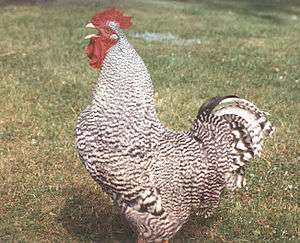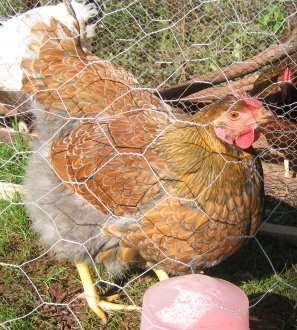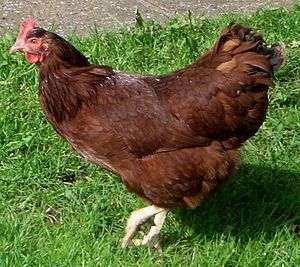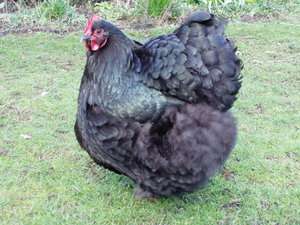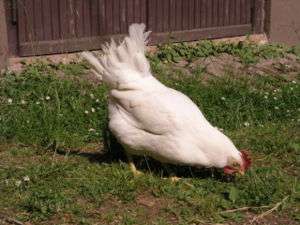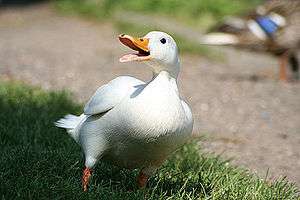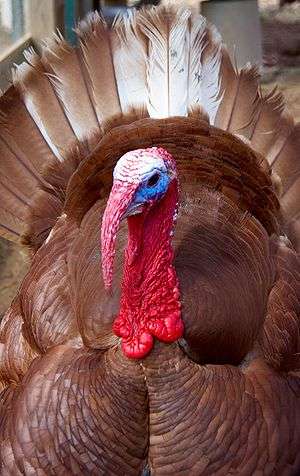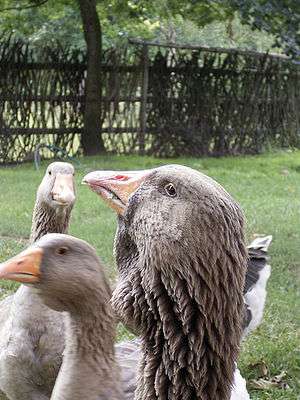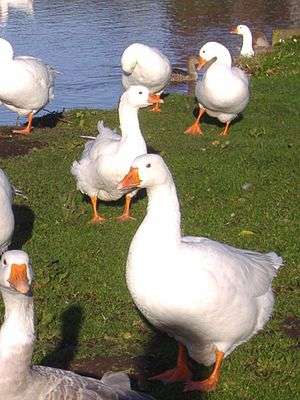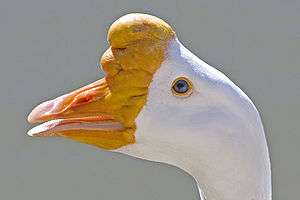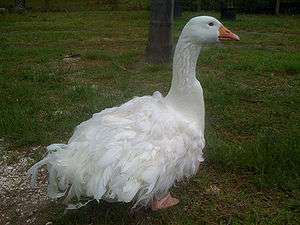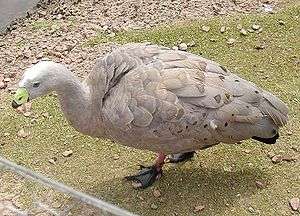Adventist Youth Honors Answer Book/Nature/Poultry
< Adventist Youth Honors Answer Book < Nature| Poultry | ||
|---|---|---|
| Nature General Conference |
Skill Level 2 |  |
| Year of Introduction: 1928 | ||
1. Identify by description and from pictures at least five breeds of chickens such as:
a. Plymouth Rock (any color)
| Plymouth Rock | |
|---|---|
|
Description: The Plymouth Rock is a chicken breed that originated in the United States in the 19th century and is still popular to this day. John C. Bennett (1804-1867) has been credited with either creating or popularizing the breed. They were developed in New England in the early 1800's by crossing Dominiques and Black Javas. It was bred as a dual-purpose fowl, meaning that it was valued both for its meat and the hens' egg-laying ability. A hen will lay between 50 and 100 eggs per year. It is a cold-hardy bird and therefore makes a great breed for the small farm or backyard flock owner. There are seven varieties of Plymouth Rock chickens: barred, blue, buff, Columbian, partridge, silver-penciled and white. |
|
b. Wyandotte (any color)
| Wyandotte | |
|---|---|
|
Description: The Wyandotte is a medium sized breast with a rose comb and clean legs. The chicken feathers are broad and close fitting. The area around the vent is very fluffy. The legs are yellow. The Wyandotte is a breed that suits both free range and confinement in a run. The hens will lay around 200 eggs a year with an exceptional hen laying around 240 eggs a year. The eggs are tinted. |
|
c. Rhode Island Red
| Rhode Island Red | |
|---|---|
|
Description: Its feathers are a Mahogany dark red/brown lustre, bordering on black. Some have purple spots or green stripes. They have red/orange eyes and yellow feet. Chicks are a light red to tan color with two dark brown bars running down their backs. Rhode Island Reds are tough birds, resistant to illness, good at foraging and free ranging, and are typically docile, quiet and friendly. Though males can be considerably aggressive. Rhode Island Reds are excellent egg layers, producing up to 250 to 300 large, light brown eggs per year. Rhode Island Reds are also bred for meat, with Cockerels weighing in at around four kilograms, and Hens slightly less. |
|
d. Orpington (any color)
| Orpington | |
|---|---|
|
Description: The Orpington is a large bird from the English class of chickens. It is a bold, upright breed with a wide chest, broad back, and smallish head and tail. The Orpington was bred as a dual-purpose breed (meat production and eggs), but its popularity grew as a show bird rather than a utility breed. Their large size and soft appearance together with their rich color and gentle contours make them very attractive. Orpingtons lay between 110 and 160 eggs a year. They do not stop laying in the winter. The eggs are tinted and range from small to large depending on the heredity of the breed. |
|
e. Leghorn (any color)
| Leghorn | |
|---|---|
|
Description: Leghorns, and leghorn crossbreeds, are one of the most popular commercial breeds of chicken worldwide, and while the majority are white, a number of colored breeds also exist. Leghorns are excellent layers of white eggs (around 300 per year), but they can be noisy, flighty, easily excited, and aggressive. Because of their aggression, they are not recommended for backyard-operations. Leghorns mature quickly, but are generally neither considered to be large birds nor suitable for meat. |
|
2. State orally or write a short paragraph regarding the egg-laying or meat-producing qualities of each breed.
These qualities are discussed in the answers for requirement 1.
3. Identify by description a Peking duck.
| Pekin duck | |
|---|---|
|
Description: A Pekin duck is a breed of domesticated duck used primarily for egg and meat production. Bred from the Mallard in China, nine ducks were imported to the United States in 1873. It is the most popular commercial duck breed in the United States. These ducks are ready for butchering at 6 to 8 weeks of age and produce more meat that is desirable for eating than other breeds of duck. Its meat is very tender and mild and well-suited for many menu options. The eggs are slightly larger than a large chicken egg, and tend to have a more durable shell and stronger membrane which makes them harder to crack open than a chicken egg. Duck eggs have more protein, calcium and many vitamins, as well as more fat and cholesterol, per gram than a chicken egg. Duck eggs are very similar in flavor and texture to a chicken egg. They can usually be substituted for large or jumbo eggs in recipes. The mascot of the insurance company Aflac is a Pekin duck. |
|
4. Identify by description and from pictures three breeds of large domestic fowl such as the following turkeys:
The three breeds listed in the requirement (Mammoth Bronze, White Holland, and Red Bourbon) are now considered "heritage breeds" and are no longer in regular commercial production. They do still exist and are bred by enthusiasts, but information about them is difficult to come by.
The scarceness of these breeds spills over to the Internet as well, making it very difficult to find photos released under a usable license. For this reason, if you can contribute photos to this project we certainly solicit you to do so. Until we have images with appropriate licenses, the best we can do is provide links to copyrighted photos elsewhere on the Internet.
a. Mammoth Bronze turkey
| Mammoth Bronze turkey | |
|---|---|
|
Description: The Mammoth Bronze is similar to the wild turkey, but it is quite a bit larger. Its feathers are an iridescent black with hints of green. The feathers of the rump have bronze coloring (thus the name), while the feathers in the front have hints of red and green.
It is calmer than most other breeds which makes them quite a bit easier to handle. Some people even use them as pets, though it is more common for them to be used for meat production. Toms weigh between 25 and 40 pounds, while hens weigh between 14 and 26 pounds. The broad-breasted is more common than the "unimproved" variety. The large breast interferes with natural mating, so they must be artificially inseminated. For images of the Mammoth Bronze, see the following |
|
b. White Holland turkey
| White Holland turkey | |
|---|---|
|
Description: The White Holland is the ancestor of the Broad-Breasted White, the most commonly produced breed of domestic turkey. True White Hollands are extremely rare these days and are bred primarily by enthusiasts. It has white feathers, pink feet, shanks, throat and wattle.
For images, see |
|
c. Bourbon Red turkey
| Bourbon Red | |
|---|---|
|
Description: The Bourbon Red is a handsome breed of turkey with white feathers at its wing tips and tail, and brownish burgundy feathers covering most of the rest of its body. It has a bluish wattle, a black beard, and pink shanks and toes. The Red Bourbon is named for Bourbon County, Kentucky where the breed was developed in the late 1800's by J. F. Barbee. Recognized by the American Poultry Association in 1909, it became a commercially important breed in the 1930's and 1940's. Its decline is attributed to the popularity of broad-breasted varieties such as the Broad-breasted White.
For more images of the Bourbon Red, see |
|
5. Identify by description and from pictures two breeds of Domestic geese such as:
a. Toulouse goose
| Toulouse goose | |
|---|---|
|
Description: The Toulouse goose has greyish-brown feathers on top, with white feathers underneath. The most distinguishing characteristic is a pronounced dewlap, which is a flap of loose skin beneath the chin. The bird is of a very trusting nature and has a very placid disposition, with the consequence that these birds do not thrive in flocks of mixed breeds. The more active and aggressive breeds will greatly distress the bird, putting them of mating and sometimes resulting in them losing out at the feeding trough. They are very domestic birds and will easily be bewildered by more active breeds if mixed. They do not need water or a pond and the geese never mate in water. They rarely have problems producing fertile eggs, although problems can occur during severe weather in the winter and spring, which is the case with most breeds of geese. The breed is a good layer of eggs and will equal the best of any goose breed. A good goose will lay up to 100 eggs a year. However the birds are not good sitters, the sitting habit having been breed out of some birds. The breed makes an excellent table bird. The geese are not great wanderers and preferring to stay close to home making them ideal for a large garden or an orchard where the birds will thrive. |
|
b. Emden
| Embden Goose | |
|---|---|
|
Description: The breed is pure white with a light orange, short, bill, and orange feet and shanks. They are fast growing birds and will quickly reach about 20lb for the Goose, and 30lb for the Gander. The Embden's legs are fairly short. The head is oval-shaped and they have a long and graceful neck. The eyes are blue. The body is bulky and well rounded, having a long back and a short tail. The wings are very strong and of a good length. The feathers are close and very hard. The breed’s habits are to forage for tidbits in the grass and water. They are a very hardy breed. The adult bird will commence laying eggs fairly early in the year, in February as a rule, laying 30 to 40 eggs. The bird is an excellent table bird. |
|
c. Chinese Geese
| Chinese Goose | |
|---|---|
|
Description: The Chinese Goose is a domesticated version of the Swan Goose. Sexes are similar, although the male is larger. The voice is a loud honking. It grazes on sedges, and rarely swims. It forms small flocks outside the breeding season. Some domesticated, introduced, or feral populations may be completely white. Some variations have a "bump" or "knob" at the top of the beak, which is more prominent on males than females. By 6–8 weeks of age, the knob is already pronounced enough that it can be used for sexing. A female goose usually lays 50–60 eggs over the course of the breeding season (February through June), although there are reports of Chinese geese laying up to 100 eggs during that time. |
|
d. Sebastopol Geese
| Sebastopol Goose | |
|---|---|
|
Description: The Sebastopol is a medium-sized goose with long, white curly feathers. The feathers of the neck are greyish-brown and smooth. Feathers on the breast may be curly or smooth. It is best to avoid breeding two specimens both having curly breast feathers, as they will develop abnormal wings. The gander weighs 12-14 lbs while the goose weighs 10-12 lbs. The legs and shanks are orange and the eyes bright blue. The breed was developed in Europe along the Danube and the Black Sea. Sebastopols cannot fly well due to the curliness of their feathers. They need plenty of water in order to keep themselves clean. For photos, see the following:
|
|
e. Cape Barren Goose
| Cape Barren Goose | |
|---|---|
|
Description: The Cape Barren Goose is a large goose resident in southern Australia. These are bulky geese and their almost uniformly grey plumage, bearing rounded black spots, is unique. The tail and flight feathers are blackish and the legs are pink with black feet. The short, decurved black bill and green cere gives it a very peculiar expression.
The Cape Barren Goose is 75-100 cm long, and has a 150-190 cm wingspan; males are somewhat larger than females. The male weighs on average 5.29 kg and the female 3.77 kg. This bird feeds by grazing and rarely swims. It forms small flocks outside the breeding season, when it wanders more widely. |
|
6. Visit a poultry farm or Agricultural Fair and write a brief report on the various types of poultry observed.
An Agricultural Fair is commonly known as a State Fair or a County Fair in the United States. A state fair is a competitive and recreational gathering of a U.S. state's population. It is a larger version of a county fair, often including only exhibits or competitors that have won in their categories at the more-local county fairs.
Originally a state fair was just a competitive exhibition of livestock in various competitions, the display of farm products which were not necessarily for sale, and the competition among various fair goers and participants in such categories as handicrafts, baked goods, jams and jellies, etc., but has since been expanded to include carnival amusement rides and games, music, races, tests of strength and skill, etc. Large fairs can see more than a million visitors over the course of a week or two.
Attending a fair like this can be a very enjoyable experience for your Pathfinders. You can find a list of state fairs in the Wikipedia article on State Fairs.
References
You can use this link to print flashcards or study the different kinds of poultry required for this honor.
http://www.flashcardmachine.com/758606/d54i
